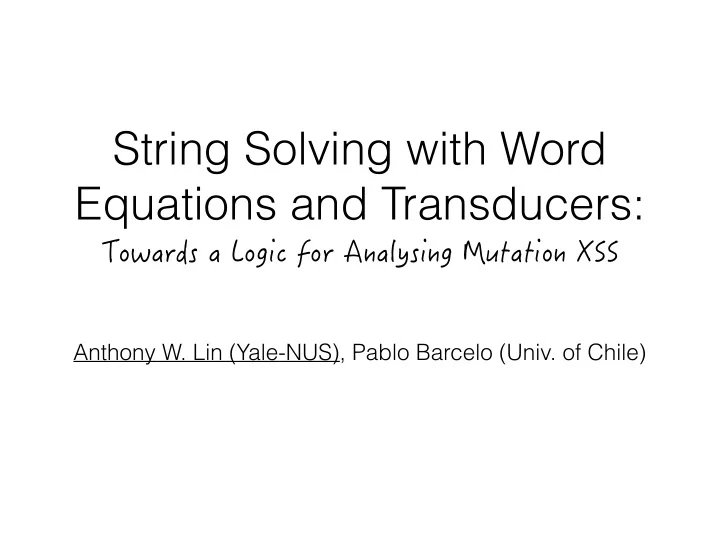

������������������������������������������ String Solving with Word Equations and Transducers: Anthony W. Lin (Yale-NUS), Pablo Barcelo (Univ. of Chile)
String Solving: A View on the Landscape
����������������������������������������������������������� What are String Solvers? Domain : the set of all words over Operations : concatenation, regex matching, length constraints, replace, replace-all, string transductions, ... A different combination of operations gives rise to a different theory over strings!! (Just as for integer domain) Many string solvers: CVC, HAMPI, Kaluza, Kudzu, Norn, Pex/Z3, PISA, S3, Saner, Stranger, StrSolve, SUSHI, Z3-str, ...
Why Develop String Solvers? • Static analysis of security vulnerabilities in web applications against code injection and XSS � ������������������������������������������������� • Automatic test case generation for scripting languages • Path query languages for graph databases
���� � ������� �������������������������������������������������������� String Solving: Theory vs. Practice • Faster heuristics each year • Much less progress on theory Which SMT over strings is decidable? 1. Word equations (Makanin’77) 2. Existential theory strings with concat (Buchi&Senger’90) 3. Word equations with regex matching (Schulz’90)
The need to add string transductions
Cross-Site Scripting (XSS)
Sanitising Input Data • Escape certain characters • EVERY occurrence of < should be changed to < • EVERY occurrence of > should be changed to > A kind of “replace-all” operation
Adding Sanitisation Google Closure <script>…</script> will be converted to <script>…<script> The script won’t be executed by Dilbert’s browser
A more tricky example (Adapted from Kern’14) escapeString “backslash-escape” certain metacharacters ‘ is replaced by ' or \’ “ is replaced by " or \” Q: Is this code vulnerable to XSS?
Analysis of the code SWAP INPUT 1: name being Tom & Jerry gives HTML markup <a onclick=“viewPerson(‘Tom & Jerry’)”>Tom & Jerry</a> INPUT 2: name being ‘);alert(1);// gives HTML markup <a onclick=“viewPerson(‘');alert(1);//’)”>');alert(1);//‘</a> innerHTML “mutates” this string to XSS! <a onclick=“viewPerson(‘’);alert(1);//’)”>’);alert(1);//‘</a>
Detecting XSS via a String Solver Step 1 : Identify “sink variables” (innerHTML, document.write) Step 2 : Find “attack patterns” from known vulnerabilities (eg, OWASP) e1 = /<a onclick="viewPerson\(' ( ' | [^']*[^'\\] ' ) \); [^']*[^'\\]' )">.*<\/a>/ Step 3 : Express the program logic in a string logic: 1. x = R1(name) 2. y = R2(x) 3. z = w1 . y . w2 . x . w3 4. nameElem.innerHTML = R3(z) 5. nameElem.innerHTML matches e1 Step 4 : Check for satisfiability
Which String Logic? 1. x = R1(name) 2. y = R2(x) 3. z = w1 . y . w2 . x . w3 4. nameElem.innerHTML = R3(z) 5. nameElem.innerHTML matches e1 concatenation R1, R2, R3 - replace-all kind of operations String transductions!
Finite-state I/O Transducers Just like finite-state automaton, but the transition label is a pair of words: ��� Erases 1 Replaces some reserved characters by HTML entity names Relation recognised by � is
Modelling sanitisation functions and implicit browser transductions Lots of works modelling these as FST or extensions thereof: Saxena et al, S&P’10 - D’Antoni&Veanes, VMCAI’13 - Hooimejer et al., USENIX Security’11 - Veanes et al., POPL’11 - … -
Is theory of strings with concatenation and FST decidable?
Undecidability Proposition (BFL’13): Checking if the constraint x = y.z & x = R(z) for a transduction R, is satisfiable is undecidable Proposition : Undecidability still holds when only allowing “erasing” transducers (i.e. replace A with an empty string)
The Straight-Line Fragment (SSA Form) Inductive Definition : (Base) An empty set of conjuncts is in SL (Inductive) If ��� is in SL with variables then is in SL, where where the ’ s are variables in or new variables regex matching : a boolean combination of
Decidability of SL Theorem : SATISFIABILITY for the class SL is decidable in exponential space (double-exponential-time) In fact, EXPSPACE-complete Theorem (Bounded Model Property): Every satisfiable constraint in SL has a solution of double-exponential size Provides some completeness guarantee of several existing string solvers Under a reasonable assumption, we get a single-exponential bound
Proof idea for decidability (without regex matching) Step 1 : Remove concatenation from the formula where has states
Bound on the size of formula without concatenation “Doubling” Trick Resulting formula uses variables Can use this trick to encode EXPSPACE Turing machines
Solving the final formula Acyclic (straight-line) Satisfiability for this kind of formulas is decidable Post/pre images of regular languages under FST are regular
Improving the upper bound The doubling tricks are artificial Limiting them into a bounded height is reasonable in practice All the examples we’ve seen in practice are of height at most 4 Theorem : SATISFIABILITY for the restricted SL is decidable in polynomial space (exponential-time) Theorem (Bounded Model Property): Every satisfiable constraint in restricted SL has a solution of exponential size
Extending the logic
Adding integer constraints Constraints of the form where is a constant integer is either: 1) an integer variable, 2) for some string variable 3) for some string variable
Decidability Theorem : SATISFIABILITY for the class SL with integer constraints is decidable in exponential space In fact, EXPSPACE-complete Theorem (Bounded Model Property): Every satisfiable constraint in SL with integer constraints has a solution of double-exponential size
Conclusion and Future Work • Concatenation and string transductions are both important for XSS applications • Straight-line fragment of string logic with concatenation and transductions (and even with integer constraints) is decidable • Future work 1 : an algorithm for computing a better estimate of the maximum size of solutions • Future work 2 : study the extension with symbolic transducers • Future work 3 : A more precise model of sanitisation functions and implicit browser transductions as transducers
Recommend
More recommend